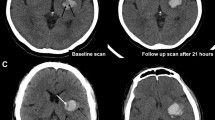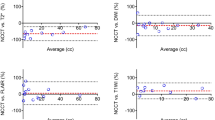Abstract
Objectives
We evaluated whether clinicians agree in the detection of non-contrast CT markers of intracerebral hemorrhage (ICH) expansion.
Methods
From our local dataset, we randomly sampled 60 patients diagnosed with spontaneous ICH. Fifteen physicians and trainees (Stroke Neurology, Interventional and Diagnostic Neuroradiology) were trained to identify six density (Barras density, black hole, blend, hypodensity, fluid level, swirl) and three shape (Barras shape, island, satellite) expansion markers, using standardized definitions. Thirteen raters performed a second assessment. Inter- and intra-rater agreement were measured using Gwet’s AC1, with a coefficient > 0.60 indicating substantial to almost perfect agreement.
Results
Almost perfect inter-rater agreement was observed for the swirl (0.85, 95% CI: 0.78–0.90) and fluid level (0.84, 95% CI: 0.76–0.90) markers, while the hypodensity (0.67, 95% CI: 0.56–0.76) and blend (0.62, 95% CI: 0.51–0.71) markers showed substantial agreement. Inter-rater agreement was otherwise moderate, and comparable between density and shape markers. Inter-rater agreement was lower for the three markers that require the rater to identify one specific axial slice (Barras density, Barras shape, island: 0.46, 95% CI: 0.40–0.52 versus others: 0.60, 95% CI: 0.56–0.63). Inter-observer agreement did not differ when stratified for raters’ experience, hematoma location, volume, or anticoagulation status. Intra-rater agreement was substantial to almost perfect for all but the black hole marker.
Conclusion
In a large sample of raters with different backgrounds and expertise levels, only four of nine non-contrast CT markers of ICH expansion showed substantial to almost perfect inter-rater agreement.
Key Points
• In a sample of 15 raters and 60 patients, only four of nine non-contrast CT markers of ICH expansion showed substantial to almost perfect inter-rater agreement (Gwet’s AC1> 0.60).
• Intra-rater agreement was substantial to almost perfect for eight of nine hematoma expansion markers.
• Only the blend, fluid level, and swirl markers achieved substantial to almost perfect agreement across all three measures of reliability (inter-rater agreement, intra-rater agreement, agreement with the results of a reference reading).





Similar content being viewed by others
Abbreviations
- CI:
-
Confidence interval
- CTA:
-
CT angiography
- EM:
-
Expansion marker
- HE:
-
Hematoma expansion
- ICH:
-
Intracerebral hemorrhage
- IQR:
-
Interquartile range
- NCCT:
-
Non-contrast computed tomography
- SD:
-
Standard deviation
References
Al-Shahi Salman R, Frantzias J, Lee RJ et al (2018) Absolute risk and predictors of the growth of acute spontaneous intracerebral haemorrhage: a systematic review and meta-analysis of individual patient data. Lancet Neurol 17:885–894
Wang X, Arima H, Al-Shahi Salman R et al (2015) Clinical prediction algorithm (BRAIN) to determine risk of hematoma growth in acute intracerebral hemorrhage. Stroke 46:376–381
Qureshi AI, Palesch YY, Barsan WG et al (2016) Intensive blood-pressure lowering in patients with acute cerebral hemorrhage. N Engl J Med 375:1033–1043
Brott T, Broderick J, Kothari R et al (1997) Early hemorrhage growth in patients with intracerebral hemorrhage. Stroke 28:1–5
Dowlatshahi D, Demchuk AM, Flaherty ML, Ali M, Lyden PL, Smith EE (2011) Defining hematoma expansion in intracerebral hemorrhage: relationship with patient outcomes. Neurology 76:1238–1244
Davis SM, Broderick J, Hennerici M et al (2006) Hematoma growth is a determinant of mortality and poor outcome after intracerebral hemorrhage. Neurology 66:1175–1181
Wada R, Aviv RI, Fox AJ et al (2007) CT angiography “spot sign” predicts hematoma expansion in acute intracerebral hemorrhage. Stroke 38:1257–1262
Demchuk AM, Dowlatshahi D, Rodriguez-Luna D et al (2012) Prediction of haematoma growth and outcome in patients with intracerebral haemorrhage using the CT-angiography spot sign (PREDICT): a prospective observational study. Lancet Neurol 11:307–314
Sprigg N, Flaherty K, Appleton JP et al (2018) Tranexamic acid for hyperacute primary IntraCerebral Haemorrhage (TICH-2): an international randomised, placebo-controlled, phase 3 superiority trial. Lancet 391:2107–2115
Barras CD, Tress BM, Christensen S et al (2009) Density and shape as CT predictors of intracerebral hemorrhage growth. Stroke 40:1325–1331
Li Q, Liu QJ, Yang WS et al (2017) Island sign: an imaging predictor for early hematoma expansion and poor outcome in patients with intracerebral hemorrhage. Stroke 48:3019–3025
Li Q, Zhang G, Huang YJ et al (2015) Blend sign on computed tomography: novel and reliable predictor for early hematoma growth in patients with intracerebral hemorrhage. Stroke 46:2119–2123
Li Q, Zhang G, Xiong X et al (2016) Black hole sign: novel imaging marker that predicts hematoma growth in patients with intracerebral hemorrhage. Stroke 47:1777–1781
Selariu E, Zia E, Brizzi M, Abul-Kasim K (2012) Swirl sign in intracerebral haemorrhage: definition, prevalence, reliability and prognostic value. BMC Neurol 12:109
Yu Z, Zheng J, Ali H et al (2017) Significance of satellite sign and spot sign in predicting hematoma expansion in spontaneous intracerebral hemorrhage. Clin Neurol Neurosurg 162:67–71
Boulouis G, Morotti A, Brouwers HB et al (2016) Association between hypodensities detected by computed tomography and hematoma expansion in patients with intracerebral hemorrhage. JAMA Neurol 73:961–968
Blacquiere D, Demchuk AM, Al-Hazzaa M et al (2015) Intracerebral hematoma morphologic appearance on noncontrast computed tomography predicts significant hematoma expansion. Stroke 46:3111–3116
Boulouis G, Morotti A, Charidimou A, Dowlatshahi D, Goldstein JN (2017) Noncontrast computed tomography markers of intracerebral hemorrhage expansion. Stroke 48:1120–1125
Fisher CM (1971) Pathological observations in hypertensive cerebral hemorrhage. J Neuropathol Exp Neurol 30:536–550
Arba F, Rinaldi C, Boulouis G, Fainardi E, Charidimou A, Morotti A (2021) Noncontrast computed tomography markers of cerebral hemorrhage expansion: diagnostic accuracy meta-analysis. Int J Stroke. https://doi.org/10.1177/17474930211061639
Morotti A, Boulouis G, Dowlatshahi D et al (2019) Standards for detecting, interpreting, and reporting noncontrast computed tomographic markers of intracerebral hemorrhage expansion. Ann Neurol 86:480–492
Nawabi J, Elsayed S, Kniep H et al (2020) Inter- and intrarater agreement of spot sign and noncontrast CT markers for early intracerebral hemorrhage expansion. J Clin Med. https://doi.org/10.3390/jcm9041020
Dowlatshahi D, Morotti A, Al-Ajlan FS et al (2019) Interrater and intrarater measurement reliability of noncontrast computed tomography predictors of intracerebral hemorrhage expansion. Stroke 50:1260–1262
Kottner J, Audigé L, Brorson S et al (2011) Guidelines for Reporting Reliability and Agreement Studies (GRRAS) were proposed. J Clin Epidemiol 64:96–106
Fedorov A, Beichel R, Kalpathy-Cramer J et al (2012) 3D Slicer as an image computing platform for the Quantitative Imaging Network. Magn Reson Imaging 30:1323–1341
Pasi M, Marini S, Morotti A et al (2018) Cerebellar hematoma location: implications for the underlying microangiopathy. Stroke 49:207–210
Donner A, Rotondi MA (2010) Sample size requirements for interval estimation of the kappa statistic for interobserver agreement studies with a binary outcome and multiple raters. Int J Biostat. https://doi.org/10.2202/1557-4679.1275
Rotondi MA (2016) kappaSize: sample size estimation functions for studies of interobserver agreement, R package version 1.2. Available via: https://CRAN.R-project.org/package=kappaSize. Accessed 1 April 2021
Landis JR, Koch GG (1977) The measurement of observer agreement for categorical data. Biometrics 33:159–174
Harris PA, Taylor R, Thielke R, Payne J, Gonzalez N, Conde JG (2009) Research electronic data capture (REDCap)--a metadata-driven methodology and workflow process for providing translational research informatics support. J Biomed Inform 42:377–381
Harris PA, Taylor R, Minor BL et al (2019) The REDCap consortium: building an international community of software platform partners. J Biomed Inform 95:103208
R Development Core Team (2021) R: A language and environment for statistical computing. Vienna, Austria: R Foundation for Statistical Computing
Gamer M, Lemon J, Fellows I, Singh P (2012) irr: various coefficients of interrater reliability and agreement. R package version 0.84.1 2012. Available via: https://CRAN.R-project.org/package=irr. Accessed 1 April 2021
Gwet KL (2019) irrCAC: computing chance-corrected agreement coefficients (CAC). R package version 1.0 2019. Available via: https://CRAN.R-project.org/package=irrCAC. Accessed 1 April 2021
Feinstein AR, Cicchetti DV (1990) High agreement but low kappa: I. The problems of two paradoxes. J Clin Epidemiol 43:543–549
Cicchetti DV, Feinstein AR (1990) High agreement but low kappa: II. Resolving the paradoxes. J Clin Epidemiol 43:551–558
Gwet KL (2008) Computing inter-rater reliability and its variance in the presence of high agreement. Br J Math Stat Psychol 61:29–48
Gwet KL (2014) Handbook of inter-rater reliability, 4th edition. Advanced Analytics, LLC, United States of America
Varmdal T, Ellekjær H, Fjærtoft H, Indredavik B, Lydersen S, Bonaa KH (2015) Inter-rater reliability of a national acute stroke register. BMC Res Notes 8:584
Hemphill JC 3rd, Bonovich DC, Besmertis L, Manley GT, Johnston SC (2001) The ICH score: a simple, reliable grading scale for intracerebral hemorrhage. Stroke 32:891–897
Morotti A, Arba F, Boulouis G, Charidimou A (2020) Noncontrast CT markers of intracerebral hemorrhage expansion and poor outcome: a meta-analysis. Neurology 95:632–643
Yang H, Luo Y, Chen S et al (2020) The predictive accuracy of satellite sign for hematoma expansion in intracerebral hemorrhage: a meta-analysis. Clin Neurol Neurosurg 197:106139
Morotti A, Dowlatshahi D, Boulouis G et al (2018) Predicting intracerebral hemorrhage expansion with noncontrast computed tomography: the BAT score. Stroke 49:1163–1169
Yogendrakumar V, Moores M, Sikora L et al (2020) Evaluating hematoma expansion scores in acute spontaneous intracerebral hemorrhage: a systematic scoping review. Stroke 51:1305–1308
Morotti A, Boulouis G, Charidimou A et al (2018) Integration of computed tomographic angiography spot sign and noncontrast computed tomographic hypodensities to predict hematoma expansion. Stroke 49:2067–2073
Law ZK, Ali A, Krishnan K et al (2020) Noncontrast computed tomography signs as predictors of hematoma expansion, clinical outcome, and response to tranexamic acid in acute intracerebral hemorrhage. Stroke 51:121–128
Falcone GJ, Biffi A, Brouwers HB et al (2013) Predictors of hematoma volume in deep and lobar supratentorial intracerebral hemorrhage. JAMA Neurol 70:988–994
Kim YS, Chae HY, Jeong HG et al (2021) Size-related differences in computed tomography markers of hematoma expansion in acute intracerebral hemorrhage. Neurocrit Care. https://doi.org/10.1007/s12028-021-01347-5
Seiffge DJ, Goeldlin MB, Tatlisumak T et al (2019) Meta-analysis of haematoma volume, haematoma expansion and mortality in intracerebral haemorrhage associated with oral anticoagulant use. J Neurol 266:3126–3135
Zimmer S, Meier J, Minnerup J et al (2020) Prognostic value of non-contrast CT markers and spot sign for outcome prediction in patients with intracerebral hemorrhage under oral anticoagulation. J Clin Med. https://doi.org/10.3390/jcm9041077
Quarfoot D, Levine RA (2016) How robust are multirater interrater reliability indices to changes in frequency distribution? Am Stat 70:373–384
Funding
LLG is funded through the following grants: Radiological Society of North America Seed Grant, Fonds de Recherche en Santé du Québec/Fondation de l’association des Radiologistes du Québec – Recherches en radiologie, Programme de support professoral du Département de radiologie, radio-oncologie et médecine nucléaire de l’Université de Montréal.
Author information
Authors and Affiliations
Corresponding author
Ethics declarations
Guarantor
The scientific guarantor of this publication is Laurent Létourneau-Guillon.
Conflict of interest
The authors of this manuscript declare no relationships with any companies whose products or services may be related to the subject matter of the article.
Statistics and biometry
No complex statistical methods were necessary for this paper.
Informed consent
Written informed consent was waived by the Institutional Review Board.
Ethics approval
Institutional Review Board approval was obtained.
Methodology
• prospective
• observational
• performed at one institution
Additional information
Publisher’s note
Springer Nature remains neutral with regard to jurisdictional claims in published maps and institutional affiliations.
Supplementary information
ESM 1
(DOCX 616 kb)
Rights and permissions
About this article
Cite this article
Nehme, A., Ducroux, C., Panzini, MA. et al. Non-contrast CT markers of intracerebral hematoma expansion: a reliability study. Eur Radiol 32, 6126–6135 (2022). https://doi.org/10.1007/s00330-022-08710-w
Received:
Revised:
Accepted:
Published:
Issue Date:
DOI: https://doi.org/10.1007/s00330-022-08710-w




